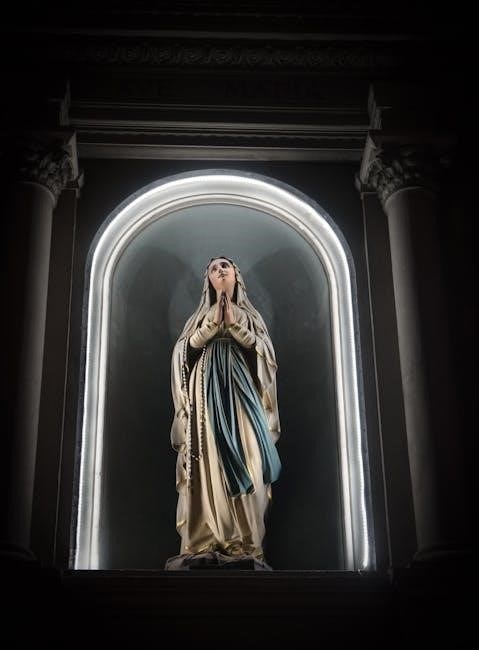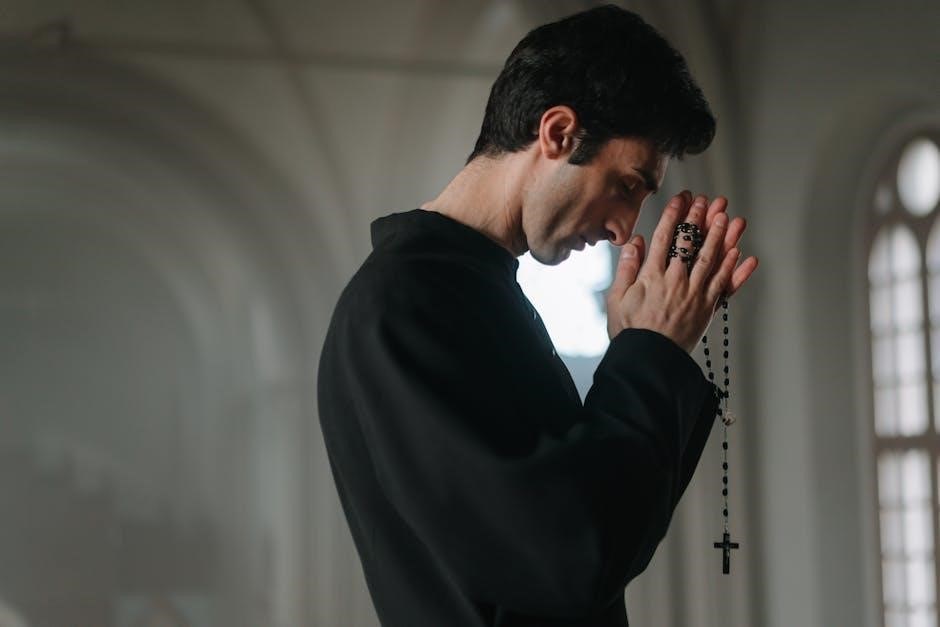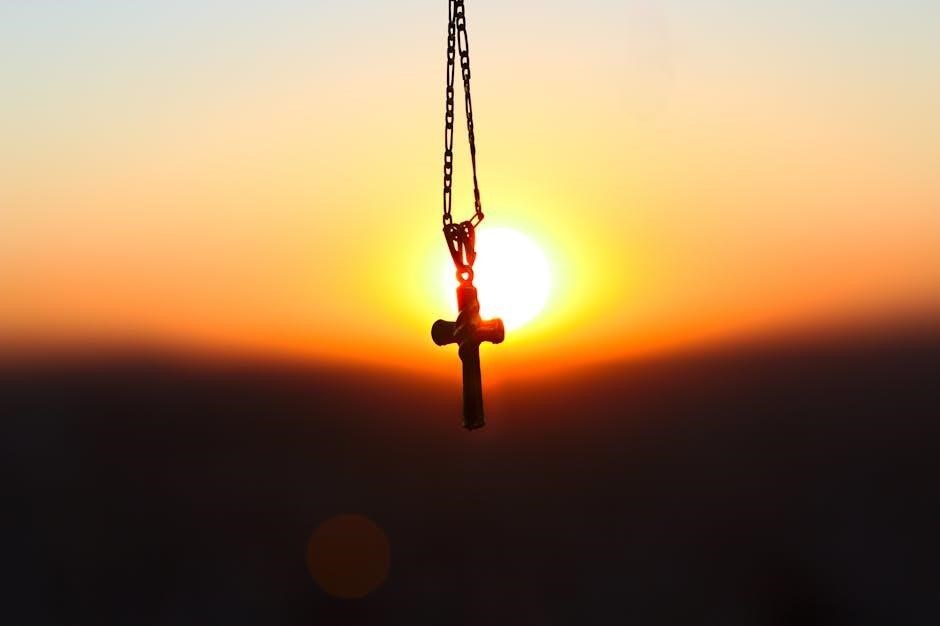Rosary for the Dead: A Comprehensive Guide
The Rosary for the Dead is a cherished tradition offering solace and spiritual support during times of bereavement. This guide provides a comprehensive overview of this sacred practice, outlining its purpose, prayers, and significance. It serves as a helpful resource for individuals and families seeking comfort and guidance.
The Rosary for the Dead is a special form of the Rosary, a powerful prayer tradition in the Catholic Church, specifically offered for the souls of those who have passed away. It is rooted in the belief that prayer can provide comfort and assistance to the departed as they undergo purification in preparation for eternal life with God. This Rosary is often prayed during wakes, funerals, memorial services, or privately by individuals seeking to honor and remember their loved ones;
The practice combines the traditional Rosary prayers with specific intentions and adaptations tailored to the deceased. It incorporates the familiar sequence of the Apostles’ Creed, Our Father, Hail Mary, and Glory Be, along with the Eternal Rest prayer, which asks God to grant eternal peace and rest to the departed soul. The Litany of Loreto may also be adapted, with prayers modified to intercede specifically for the deceased.
The Rosary for the Dead is a profound expression of faith, love, and remembrance. It offers a way for the living to connect with the departed, seeking God’s mercy and offering spiritual support during a time of grief and transition.
Purpose of Praying the Rosary for the Deceased
The primary purpose of praying the Rosary for the deceased is to offer spiritual assistance and comfort to the souls of the departed. Catholics believe that after death, souls may undergo a period of purification, often referred to as Purgatory, to cleanse them of any remaining imperfections before entering Heaven. The prayers of the living can help to ease this process and hasten their entry into eternal rest.
The Rosary serves as a powerful intercessory prayer, asking for Mary’s intercession with God on behalf of the deceased. By reciting the prayers of the Rosary, we express our love, remembrance, and concern for the departed, entrusting their souls to God’s mercy and compassion. It’s a way to connect with them spiritually and offer them the gift of prayer.
Praying the Rosary for the deceased also provides comfort and solace to the bereaved. It offers a sense of peace and hope during a difficult time, reminding us of the promise of eternal life and the communion of saints. It becomes a communal act of faith and support.
Prayers Recited During the Rosary for the Dead
The Rosary for the Dead comprises a sequence of specific prayers recited in a structured manner. It begins with the Sign of the Cross, followed by the Apostles’ Creed, a profession of faith. The Our Father, or Lord’s Prayer, is then recited, expressing our dependence on God.
The Hail Mary, a prayer of praise and petition to the Virgin Mary, is repeated multiple times throughout the Rosary. The Glory Be, a doxology praising the Holy Trinity, follows each decade of Hail Marys. A crucial element specific to the Rosary for the Dead is the inclusion of the Eternal Rest Prayer, also known as the “Requiem Aeternam,” after each decade.
This prayer implores God to grant eternal rest to the deceased and let perpetual light shine upon them. In some instances, the Litany of Loreto may be adapted, replacing “us” with “the soul of” the deceased, to personalize the intercession. These prayers, combined with meditation on the mysteries of the Rosary, create a powerful and meaningful prayer experience.
The Apostles’ Creed

The Apostles’ Creed is a foundational statement of Christian belief, serving as a concise summary of essential doctrines. It is traditionally recited at the beginning of the Rosary, including the Rosary for the Dead, to affirm faith in God and the core tenets of Christianity.
The creed begins with a declaration of belief in God, the Father Almighty, creator of heaven and earth. It then professes faith in Jesus Christ, God’s only Son, our Lord, who was conceived by the Holy Spirit, born of the Virgin Mary, suffered under Pontius Pilate, was crucified, died, and was buried. The creed continues by stating belief in Christ’s descent into hell, his resurrection from the dead on the third day, his ascension into heaven, and his future return to judge the living and the dead.
Finally, the Apostles’ Creed affirms belief in the Holy Spirit, the holy catholic Church, the communion of saints, the forgiveness of sins, the resurrection of the body, and life everlasting. By reciting this creed, individuals participating in the Rosary for the Dead express their shared faith and hope in eternal life for the departed.

Our Father
The “Our Father,” also known as the Lord’s Prayer, holds a central place in Christian prayer and is an integral part of the Rosary for the Dead. This prayer, taught by Jesus himself, expresses a profound connection with God and a desire for His will to be done on Earth as it is in Heaven.
The prayer begins by addressing God as “Our Father,” acknowledging His loving and paternal nature. It then asks for His name to be hallowed, His kingdom to come, and His will to be done, reflecting a submission to God’s divine plan. The “Our Father” also includes a petition for daily sustenance, asking for “our daily bread,” recognizing our dependence on God’s provision.
Furthermore, the prayer seeks forgiveness for our trespasses, as we forgive those who trespass against us, emphasizing the importance of both receiving and extending forgiveness. Finally, it asks for protection from temptation and deliverance from evil, acknowledging the challenges and struggles of earthly life. Reciting the “Our Father” during the Rosary for the Dead offers comfort and hope, entrusting the departed to God’s loving care.
Hail Mary
The “Hail Mary” is a foundational prayer in the Rosary, deeply rooted in Catholic tradition and devotion to the Virgin Mary. During the Rosary for the Dead, this prayer takes on special significance, offering solace and intercession for the departed soul. The prayer’s words are drawn from the Gospel of Luke, combining the Archangel Gabriel’s greeting to Mary (“Hail, full of grace, the Lord is with thee”) and Elizabeth’s blessing (“Blessed art thou amongst women, and blessed is the fruit of thy womb, Jesus”).
The second part of the “Hail Mary” is a petition, asking Mary, the Mother of God, to “pray for us sinners, now and at the hour of our death.” This plea recognizes Mary’s unique role as intercessor, seeking her prayers for both the living and the deceased. By reciting the “Hail Mary” in the Rosary for the Dead, we entrust the departed to Mary’s loving care, asking her to present their souls to God. The prayer provides comfort and hope, reinforcing the belief in Mary’s powerful intercession and God’s boundless mercy.
Glory Be
The “Glory Be” prayer is a short doxology, a hymn of praise to the Holy Trinity, recited frequently during the Rosary, including the Rosary for the Dead. It affirms the Christian belief in one God existing in three persons: Father, Son, and Holy Spirit. The prayer’s simplicity and profound theological depth make it a powerful expression of faith and adoration.
In the context of the Rosary for the Dead, the “Glory Be” serves as a reminder of God’s eternal nature and glory, offering comfort and hope amidst the sorrow of loss. By reciting these words, “Glory be to the Father, and to the Son, and to the Holy Spirit. As it was in the beginning, is now, and ever shall be, world without end. Amen,” participants acknowledge God’s sovereignty over life and death, trusting in His promise of eternal life for those who believe. The prayer underscores the belief that the departed soul now shares in God’s glory, finding rest and peace in His presence.
Eternal Rest Prayer

The “Eternal Rest” prayer, also known as the “Requiem aeternam,” is a central component of the Rosary for the Dead, offering a heartfelt plea for the departed soul. This prayer seeks God’s mercy and eternal peace for the deceased, expressing the hope that they may find solace in His loving embrace.
The words, “Eternal rest grant unto them, O Lord, and let perpetual light shine upon them. May they rest in peace. Amen,” encapsulate the essence of this prayer. It is a supplication for God to grant the departed eternal rest, freeing them from earthly suffering and welcoming them into His heavenly kingdom. The phrase “perpetual light” symbolizes the divine presence and the hope of everlasting life, guiding the soul through darkness and into the radiant glory of God.
Reciting the “Eternal Rest” prayer during the Rosary for the Dead serves as a powerful act of intercession, uniting the living and the departed in a bond of prayer and love. It provides comfort to those grieving, reminding them of God’s promise of eternal life and the hope of reunion in His presence.
Litany of Loreto (adaptations for the deceased)
The Litany of Loreto, a Marian prayer invoking the Blessed Virgin Mary under various titles, can be adapted for the Rosary for the Dead to specifically intercede for the departed soul. This adaptation involves modifying the traditional litany to direct the prayers towards the deceased, seeking Mary’s intercession for their eternal rest and peace.
Instead of praying “Pray for us,” the litany is adjusted to “Pray for the soul of (Name)” or “Pray for them.” This subtle yet significant change focuses the prayer on the individual who has passed away, asking Mary to plead on their behalf before God. Each title of Mary, such as “Holy Mother of God,” “Virgin most pure,” and “Queen of Peace,” becomes a specific request for her to assist the departed soul in their journey to eternal life.

By adapting the Litany of Loreto, the Rosary for the Dead becomes an even more personalized and powerful prayer, expressing deep love and concern for the deceased while entrusting them to the compassionate care of the Blessed Virgin Mary, seeking her maternal assistance in obtaining eternal rest for their soul.
How to Pray the Rosary for the Dead
Praying the Rosary for the Dead follows a similar structure to the traditional Rosary, with specific adaptations to focus intentions on the deceased. Begin with the Sign of the Cross, followed by the Apostles’ Creed, expressing faith in core Christian beliefs. Then, recite the Our Father, Hail Mary, and Glory Be prayers, meditating on the mysteries of the Rosary while offering each decade for the soul of the departed.
After each decade, include the “Eternal Rest” prayer: “Eternal rest grant unto them, O Lord, and let perpetual light shine upon them. May their souls and all the souls of the faithful departed, through the mercy of God, rest in peace. Amen.” This prayer specifically requests God’s mercy and eternal peace for the deceased.
Consider adapting the Litany of Loreto by changing “Pray for us” to “Pray for the soul of (Name)” to personalize the prayer further. Throughout the Rosary, focus your thoughts and intentions on the deceased, remembering their life, virtues, and the love you shared. Praying with sincerity and devotion offers comfort to the bereaved and spiritual assistance to the departed soul.
Benefits and Significance of Praying the Rosary for the Dead
Praying the Rosary for the Dead offers numerous spiritual benefits, both for the deceased and those who pray. It provides comfort and solace to grieving family and friends, offering a structured way to express their love and remember the departed. The Rosary serves as a powerful intercessory prayer, seeking God’s mercy and eternal rest for the soul of the deceased.
The practice also strengthens the faith of those who participate, reminding them of the promise of eternal life and the communion of saints. By meditating on the mysteries of the Rosary, individuals can find peace and hope amidst sorrow, deepening their connection with God and the Blessed Virgin Mary.
Furthermore, praying the Rosary for the Dead is considered an act of charity and spiritual mercy, offering assistance to souls in purgatory. It reflects the Catholic belief in the power of prayer to aid the departed in their journey to eternal life. This tradition reinforces the importance of remembrance, faith, and communal support during times of loss, fostering a sense of unity and spiritual connection within the community.
